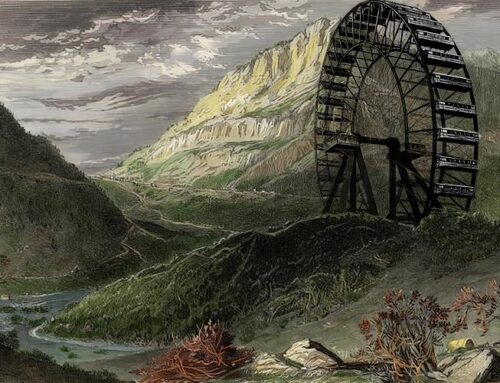Although the 1893 World’s Columbian Exposition ran during the warm months of May through October, a touch of Christmas could be found on the fairgrounds. Nestled in the northwest corner of the German Pavilion inside the Manufactures and Liberal Arts Building (Section F, 77-79), the toy manufacturers of Sonneberg, Germany, featured a lovely display of toys and dolls filling an ornate carriage and topped by a Christmas tree.

A photograph of the German toy exhibit in the Manufactures and Liberal Arts Building. [Image from Shepp’s World’s Fair Photographed (Globe Bible Publishing Co., 1893).]
Mecca of the child’s pilgrimage
Shepp’s World’s Fair Photographed describes the exhibit:
“There is on the Fair Grounds a house devoted entirely to children, but the real Mecca of the child’s pilgrimage is to the Sonneberg exhibit of toys, in the German Pavilion, in the Manufactures and Liberal Arts Building. The German, above all things else, is a family man, and devotes the best of his life to the good of his children. It is not then wonderful that Germany should be the land of toys, and that the world should go to her for those fanciful devices which amuse and often instruct children. A glance at our picture will show the wonderful variety of toys exhibited by a single firm. Time was when all the German dolls looked alike; they might be ever so tiny and so large, they might open and shut their eyes at the pleasure of the owner, and even wail faintly when the body was pressed between the finger and thumb, but the same blonde, complacent face, the same blue wondering eyes, the same flaxen hair, was sure to be in evidence. Now all is changed. France, with her piquant-faced dolls, used to lead the way; to-day Germany treads sharply on her heels, and the spirituelle brunette in every form and style holds equal empire with the placid blonde. In the foreground of our picture a jaunty horse is seen attached to an old-fashioned coach, in which is a Christmas tree, covered with a bewildering profusion of toys, dainty and grotesque. The Christmas tree is dear to the heart of the German child. Christmas eve, after the little ones have knelt at the mother’s knee and lisped the sweet prayer—
“Christ kindchen, komm,
Mach mich fromm,
Das ich zu Dir in Himmel komm”—
there is little sleep, and early in the morning they are awake and astir to see what the good Herr Nicholas has done for them. In this picture a rash young lady doll strides the proud steed that draws the Christmas tree. Toys of every description, yachts, steamboats, dogs, horses, the whole fanciful world of a child is before us. The little ones stand and gaze, and even grown-up persons turn away and sigh as they remember the ragbabies and clumsy carts of their youth, and compare them with what children can now enjoy. This exhibit will be retained by the childish memory long after more important features of the Exposition have faded away.” [Shepp, p. 114-15]

Stereograph card publisher Strohmeyer & Wyman printed their image of the display with the caption “The arrival of Santa Claus at the World’s Fair, (German toy exhibit).”
Quaint region of Puppenland
World’s Columbian Exposition Illustrated noted that the exhibit, described as “one of the most artistic and interesting displays of the kind made in the building,” included the creations of “about twenty toy firms of Sonneberg.” [“German Toy Exhibit”]
The village of Sonneberg lies in the “quaint region of Puppenland” in a mountainous province of central Germany, reported the Chicago Daily Tribune a month before the World’s Fair opened. “Under every roof in the locality can be seen grandfathers, parents, and children busily employed in basting, sewing, cutting, pressing, or painting on some constituent part of the doll’s anatomy.” [“Quaint Dollie Land”]

B. W. Kilburn stereograph card 8851 “Santa Claus has come again.” An 1895 stereoscope catalog described the scene: “No nation in the world furnishes so many toys for the pleasure of children as Germany. This wonderful toy chariot contains every imaginable article of amusement, and is a veritable toy paradise.” [Davis, p. 28]
Sonneberg today is home to the German Toy Museum (“Deutsches Spielzeugmuseum”).
World’s Columbian Exposition Illustrated reported that “a prominent Chicago dry goods house has already purchased the exhibit and will have it among their holiday displays at the close of the Fair.” Which department store received the toy display remains a mystery. The famous Marshall Field’s Christmas window displays did not begin until 1897.

B. W. Kilburn stereograph card 8003 titled “The Great Austrian Exhibit” misidentifies the source of the toy display.
SOURCES
Davis, James M. James M. Davis’s Descriptive Catalogue of Celebrated Original Retouched Stereoscopic Views, 1895.
Heinen, Joseph C.; Heinen; Susan Barton Lost German Chicago. Arcadia, 2009.
“Quaint Dollie Land” Chicago Daily Tribune, Apr. 2, 1893, p. 33.
Shepp, James W.; Shepp, Daniel B. Shepp’s World’s Fair Photographed. Globe Bible Publishing Co., 1893.
“German Toy Exhibit” World’s Columbian Exposition Illustrated Volume 3, No., 6, August 1893, p.142.






Leave A Comment